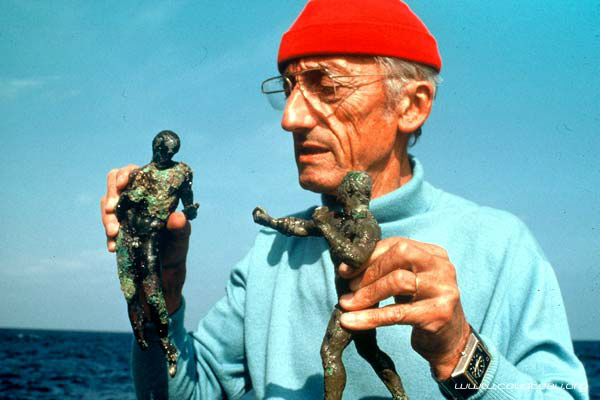
This year marks the anniversary of the birth of a pioneer who changer the world's view of the oceans for posterity. Born in 1910 at Gironde, France, Jacques Ives Cousteau originally wanted to pursue a career in naval aviation, but an auto accident changed his plans to the oceans instead. After graduating from the French Naval Academy as a gunnery officer, he began his underwater observations while still in the navy.
A few years after his marrage to Simone Melchior, World War II was in progress. The couple and their two young sons, Jean Michel and Philippe, moved to Megeve, where Cousteau met mountaineer Marcel Ichac. Inquisitive of life beneath the sea, Cousteau and Ichac made the first French underwater film named "18 meters deep." That same year in 1943, when Cousteau was 33 years old, he devised a prototype of an aqualung with the assistance of Emile Gagnan, a French-Canadian engineer and inventor.
After undertaking various expeditions and an archaeological dive to an ancient Roman wreck off the Tunisian Coast, Cousteau resigned his commission from the French navy in 1949. The following year, he founded the French Oceanographic Institute, and leased from Irish millionaire, Thomas Loel Guinness, the now famous CALYPSO and refitted the ship into a floating laboratory and ocean research vessel.
Among the things Cousteau pioneered along with his friend Jean Molland, was a diving saucer, a mini submersible with a crew of two that could dive to 1,000 feet. In the 1960s another small one man version named the SEA FLEA, could even dive to a greater depth.
Like the astronauts experimented living in space stations, Cousteau had the vision of "oceanauts" living in a confined station independed of an anchored vessel above them. Thus, the Conshelf was devised as a kind of underwater village for underwater research. In 1965, Conshelf III was created that could house up to six "oceanauts" for three weeks.
Cousteau envisioned a propulsion system that uses energy like the wind, thus the Turbosail was developed. He also predicted the sonar capabilities of porpoises that swam alongside his research vessel.
Throughout his career, Cousteau made 120 TV documentaries and wrote over 50 books. In 1956, his film "The Silent world", won recognition at the Cannes Film Festival. In 1960, he rallyed public support to hault dumping toxic atomic waste into the sea.
After his wife passed away in 1991, Cousteau married Francine Triplet, who now manages The Cousteau Society along with his son Philippe. This Society (www.cousteau.org) has established an ocean monitoring program called Cousteau Divers, which bring together worldwide divers for marine conservation.
In 1997, Cousteau died in Paris from heart failure at age 87. To mark the anniversary of Cousteau's birth, a year long celebration which includes the restoration of the CALYPSO, which when completed will go on a world tour as an eduction exhibition.

The research ship CALYPSO, was built from Oregon pine as a wooden minesweeper at the Ballard Marine Railway Co. at Seattle, Washington. Launched on March 21, 1942, she was transfered to the British Royal Navy in February 1943, as the HMS J-826 and assigned to the Mediterranean Sea.
Struck from naval service in 1947, CALYPSO was sold to private interest as a ferry between the island of Malta and the island of Gozo. In 1950, Irish millionaire, Thomas Loel Guinness, bought CALYPSO and leased it to Captain Cousteau, who transformed the ship in a lab and research vessel.

In 1996, CALYPSO was badly damaged when she was rammed and sunk by a barge when CALYPSO was on a tour that stopped at Singapore. The vessel was raised and towed back to France. Years of wrangling between Cousteau family member of how to plan the future of CALYPSO, and lack of funds delayed restoration of the ship. The ship is now being restored at a shipyard in Brittany, France. When the restoration is completed in time for the Cousteau anniversary, she will serve as a training and educational exhibit.
Adopted and edited from the article by Allen Koay
Montani semper liberi ! Happy modeling to all and every one of you.
Crackers 